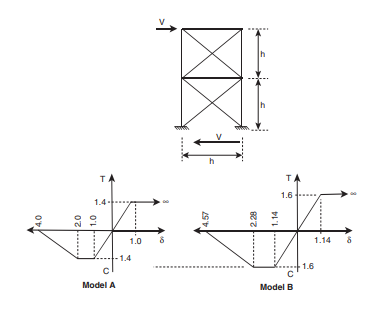A two-story concentric braced frame is to be studied using a displacement response history analysis method (i.e., push-over analysis using plastic analysis). The intent here is to compare the behavior of two structures under the following assumptions. Two brace tension-compression models are as shown below, where δ is the brace axial displacement (not the story displacement). The braces of the first structure are entirely made of model A, whereas the braces of the second structure are of model A at the top story, and model B at the bottom story. All columns can be assumed to remain elastic. In both cases, a load is applied at the top of the second story. The displacement at the point of load application is increased until the compression brace at the second story has no more strength (the end of the compression range on the brace tension-compression model shown as follows). For each structure, plot the base shear (V) as a function of the frame’s top displacement, Δ. Compare the hysteretic behavior of the two frames. Comment on:
• Which frame has the best energy dissipation capacity? Note that energy is expressed by the area under the force-displacement curve (force times displacement equals work, which itself is a measure of energy), less the elastically recoverable part of the energy (i.e., work done in the initial elastic range).
• Which frame has members undergoing the largest inelastic excursions for a given frame displacement, and which frame undergoes the largest inelastic excursion for a given member deformation?
• Which frame has the best capacity for a given frame displacement?
• Which frame sees the largest member deterioration for a given frame displacement?


